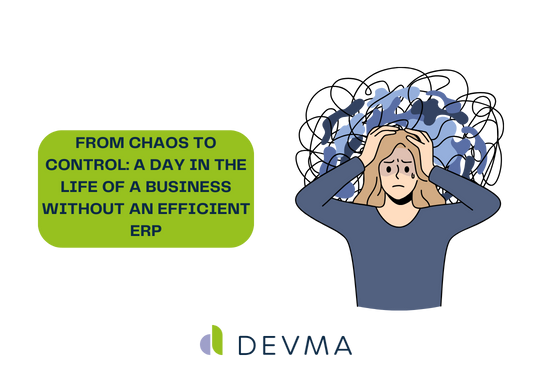Last update: Oct 2, 2024
From Chaos to Control: A Day in the Life of a Business Without an Efficient ERP

Table of contents
Picture this: It’s 9 a.m., and the sales team is scrambling to close a big deal. The client is ready to sign—and they’re a big fish. But before they seal it, the team needs to check inventory levels. They fire off a bunch of emails to the warehouse, waiting for a response. Meanwhile, accounting is manually entering last week’s sales data into spreadsheets—a process fraught with possible errors.
By noon, orders are piling up, but the lack of integration between operations means shipments can’t be prioritized worth a darn. The client starts tapping their foot, and that promising deal is now on shaky ground. Customer service is left fumbling when a customer calls to ask about an order’s status.
By the end of the day, finance is still stitching together scattered data from various departments for their reports, and the sales team has lost the morning’s deal due to delays. Production is also out of sync, rushing orders or delaying deliveries, putting even more pressure on the whole team.
Stressful, huh? I even gave myself anxiety painting that picture for you. But that picture is one you can get used to if your business doesn’t have an efficient ERP system.
The Chaos
Without an ERP system, businesses operate in a constant state of disorder. Manual processes eat hours instead of minutes, departments can’t communicate effectively, and real-time data is nowhere to be found. Not only does this mess of a business lead to lost opportunities and unhappy customers, but it also creates a culture of inefficiency and frustration among employees. Business decisions are delayed, operations are sluggish, and scaling the business becomes nearly impossible.
The Control
Now, picture this: Every department has access to the same real-time data. The sales team checks inventory on the spot, closes the deal, and processes the order without a hitch. Customer service representatives are empowered with the information they need to answer questions in real-time, and the finance team would no longer have to manually input data, allowing them to focus on analyzing trends and making informed decisions. With an efficient ERP, all departments have real-time access to the same centralized data.
On the production side, an ERP system allows for accurate demand forecasting, ensuring the operations team can plan ahead and avoid delays or rush orders. Best of all, tying all your business processes into a single platform means smoother communication, fewer errors, and an overall boost to the efficiency of your business.
The Blueprint for an Efficient ERP
An ERP system can be the backbone of your business, so making sure it runs smoothly is crucial. Here’s how to guarantee your ERP is efficient, optimized, and future-proof:
1. Pick the Right One
Choose an ERP system that aligns with your business goals. Whether it’s streamlining finance, managing inventory, or improving customer service, your ERP needs to fit your specific needs. Make sure it’s scalable, flexible, and designed for your industry.
2. Strategic Implementation
Don’t rush it. Roll out your ERP in phases, starting with high-priority modules. Involve stakeholders early on to reduce friction. A slow, thoughtful approach reduces risk and helps teams adapt better.
3. Training is Crucial
Even the best ERP won’t do you any good if your team doesn’t know how to use it. Comprehensive training from day one ensures everyone is confident. Keep training ongoing to stay updated with upgrades or new features.
4. Keep It Updated
An ERP isn’t a set-it-and-forget-it tool. Regular updates ensure optimal performance and security. Work with your vendor to schedule regular maintenance and stay on top of system health.
5. Leverage Automation
Use your ERP to automate repetitive tasks like payroll, inventory tracking, and order processing. Automation saves time, reduces errors, and frees up your team for more strategic work.
6. Prioritize Security
Protect your data. Make sure your ERP includes strong encryption, access controls, and a reliable backup system. Regular security audits are a must to prevent breaches.
7. Continuous Improvement
Always look for ways to improve. Gather feedback from users and monitor system performance to spot inefficiencies and make the necessary tweaks.
By selecting the right system, ensuring proper training, leveraging automation, and prioritizing security, you’ll keep everything running like clockwork—allowing your business to scale with confidence.